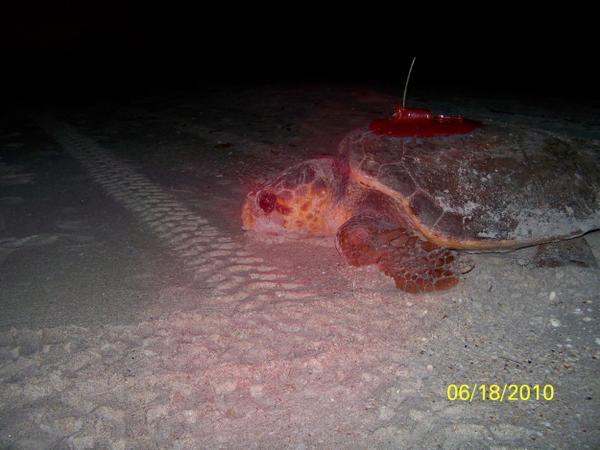When Eleanor the sea turtle was caught in a tropical storm off the coast of Florida, she coped surprisingly well. In fact, she hardly needed to use any extra energy during the four days the storm raged – and neither was she injured.
As the seas get warmer, the Earth suffers the ravages of ever more powerful storms and hurricanes, with massive consequences for both humans and animals. One of the concerns is marine animals, especially endangered species, such as certain whales, manatees, sharks, sea turtles, etc.
A joint Danish/American/Australian team of researchers has discovered that severe weather is not necessarily harmful to individual adult sea turtles. The team was in the process of monitoring sea turtles fitted with GPS transmitters and motion sensors off Sarasota in the USA, when one of the sea turtles was unexpectedly caught in a tropical storm. This provided the team with a unique opportunity to see how a sea turtle would cope with a storm.
“We were delighted to find that she rode out the storm in style without any problem,” says Maria Wilson, a biologist at the University of Southern Denmark (SDU).
The study was conducted in 2012 involving colleagues from Mote Marine Laboratory and Aquarium, Sarasota in Florida, Department of Parks and Wildlife, Marine Science Program in Australia and Aarhus University in Denmark. A scientific article has now been published in the Journal of Experimental Biology.
“We know little about how sea turtles manage during hurricanes and tropical storms. Storms could blow sea turtles off course, or surviving a storm could be so exhausting that it drains energy reserves and thus the ability to survive and produce eggs, thereby having a negative impact on the next generation of sea turtles,” explains Wilson.
The tagged sea turtle caught in the storm is named Eleanor. She was at sea in the Mexican Gulf in the egg-laying season when she was hit be the storm. Consequently, she had already nested on one of Florida’s beaches and had returned to the sea to replenish her energy reserves before coming back to lay more.
Eleanor was caught in tropical storm Debby, which passed through the Mexican Gulf between 23rd and 27th June 2012. Debby caused extensive flooding in Florida, reaching wind speeds of up to 100 kph.
Eleanor was tagged for 16 days, four of which were during the storm. Data from the GPS and animal motion tags showed that she drastically changed behaviour when the storm struck. Before the storm, she rested on the seabed, moving only to go to the surface for air.
When the storm struck, she moved further north than expected. According to the researchers, she was forced by prevailing currents. She also changed her diving patterns, becoming much more active instead of saving energy for the next egg-laying event.
“Even though Eleanor swam for most of the four days the storm raged, she was good at saving energy, ending up actually using no more than she would normally use to produce 12 eggs. Given that sea turtles lay somewhere between 300 and 900 eggs during a nesting season, that’s not much. But another fantastic element of Eleanor’s story is that, despite the storm pushing her more than 100 km north of ‘her’ beach, she swam south when it passed and made her nest just 75 metres from her last one – although with a few days’ delay,” adds Wilson.
The researchers calculated Eleanor’s energy consumption based on motion sensors (3D accelerometers and gyroscopes), which detected when she was swimming. How much energy a swimming sea turtle uses had been determined from earlier experiments in the laboratory, making it possible to estimate how much energy they use sea.
Even though it would seem that sea turtles are sufficiently robust to avoid being at the mercy of storms, such a powerful storm can still be a major threat to them.
“Sea turtles lay their eggs on the beach, and their nests are extremely vulnerable to passing storms. The storm that Eleanor easily survived destroyed almost 90% of nests on the beach where she and several hundred other female turtles had laid their eggs.”
That’s why Maria Wilson urges more focus on protecting nests and helping newly hatched turtles and less on adults, when the discussion turns to protecting sea turtles.


